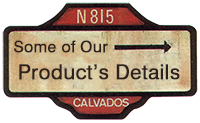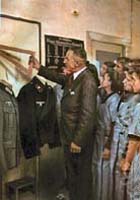

- Lost Battalions Gets Mention in the Times of London
- About the "M43" Cap
- The wearing of Field Caps ("Crushers") by SS or Army NCOs
- Branch color (Waffenfarbe) on SS Field Caps (aka: The Crusher Cap)
- German Wool Fabric and Manufacturing of World War Two by Raymond A. Velasco
- The Proper Fit of the German Field Blouse
- M43 Historical Development and Reproduction
- Enlisted Rank Structure of the Army, SS and Air Force
- Officer Rank Structure of the Army, SS and Air Force
(Imperial German)
Uniforms





Lost Battalions' Resource Page
This resource page gives useful information
about WW2 German uniforms.

(Please read this page before
ordering any clothing.)

Bargain Bunker
Check out our latest sales
and good deals.
Click here to visit our
Gallery Page
German Wool Fabric and Manufacturing of World War Two
by Raymond A. Velasco
This article is copyrighted completely or in part, ©2005 Raymond Velasco
 Below: Typical weave constructions used in cloth manufacturing. |
The wool used for the production of standard issue German field blouses issued from 1933 to 1945 was a plain weave, heavily felted wool with a fabric weight of 16-17 ounces. Some slight amount of twill used in trousers.
Fabric In garment making, there are three basic weaves used on most fabrics, satin, plain and twill. And of the three, the plain weave is the simplest and the most common of all of the weaves.
In a plain weave there is a distinct checkerboard pattern formed when the lengthwise warp yarn passes over, under, over, under the crosswise filling yarn. This weave is not as strong as the twill weave, thus causing the garment being easily torn, wrinkled, and wears much quicker than the other weaves. As a plus, “plain weave” fabrics are not as absorbent as twill or satin woven fabrics because of the tightness of the weave making them perfect for shedding moisture like light rain.
The composition of wool fabric used for German field blouses was wool fiber with viscose filler (viscose rayon). Prior to the first shots fired in Poland in 1939, the best quality German field blouse wool that could be had was 85% wool to 15% viscose rayon mix. This changed for the worse as the war progressed. Viscose rayon content increased when the war started. The first major increase of viscose rayon in wool was around March of 1940. This increase set the percentage of wool to viscose rayon at about 50%-50% and made its introduction into service in the Model 40 and Model 41 field blouses and various other garments. This worsened throughout the war and the composition ultimately reached 15% wool to 85% viscose rayon/recycled fiber on fabric made after 1942. Later fabric included recycled fiber from old, worn uniforms or from clothing donations made for the war effort. This viscose rayon/ recycled fabric filler lead to a quite inferior and unattractive wool as compared to the wool that was manufactured prior to the Battle of France in 1940.
Cellulose fiber production had and still has a very strong presence in Germany because of the abundance of trees. The Germans knew that they can synthetically manufacture any fabric, silk, cotton, wool with this material and did not have to worry about sourcing raw silk, cotton or wool for fabric production. We better know cellulose-based fabrics (depending on chemical process) as rayon, viscose rayon and acetate. Referred to as “dissolving pulp,” the cellulose is produced from specially processed wood pulp. Rayon is purified cellulose converted chemically into a soluble compound. This compound is then passed through a spinneret to form soft filaments that is thus converted into almost pure cellulose. Rayon is referred to as a “regenerated cellulose fiber” because of this conversion from a soluble compound into cellulose fiber. Viscose rayon is manufactured by converting the cellulose to xanthate. The xanthate is dissolved in caustic soda and thus regenerating the cellulose from the product as it is extruded from the spinneret. Most rayon is made in this process and is seen in the diagram to the right. Dated to the early 1900’s, most of this type of rayon production was done between 1925 to around 1955.
Even though the Germans used viscose rayon as filler in wool production, its main drawback was its lack of tinsel strength. Wet cellulose, like paper, has no pull (tinsel) strength and is easily torn apart. The same is true with any fabric that is manufactured with a high cellulose-based fiber content. The seams tend to give way when the garment gets wet or a folded edge on a hem like a cuff or collar would begin to wear quickly and create holes. The reason why German army field blouses went to a six-button front after the battle of France is due to the increase of viscose rayon content with wool. The SS really did not care about this dilemma and still retained the five-button front on later field blouses.
|
Below: Diagram of how Viscose Rayon is manufactured. |
Color The idea that field gray was one specific color is a myth that deserves a long and horrible death. From sea foam green to almost brown grey, the field gray color of the German field blouse was all over the map but stayed within a range. An excellent photo of this, taken by Rollin Curtis, is on At the Front’s web site; http://www.atthefront.com/Fieldgrey.jpg. There are many mitigating factors that caused this. Some examples are; a lack of a defined “field gray,” different companies manufacturing dye for wool fibers, different companies dying fibers, different companies spinning yarn, the heathering effect in woven wool, the increase of viscose rayon, the increase of recycled pulped up fabrics, washing and drying. The Germans “stock dyed” their wool. This process is where the wool fibers are dyed and then spun into yarn for weaving, creating a heathered look (This is where you can see distinct color fibers and the color is not uniform throughout the garment). The German’s did not “package dye” (dying the yarn after being spun), “piece dye” (dying the fabric after being woven), or “garment dye” (dying the garment after being sewn together) their field blouse wool.







